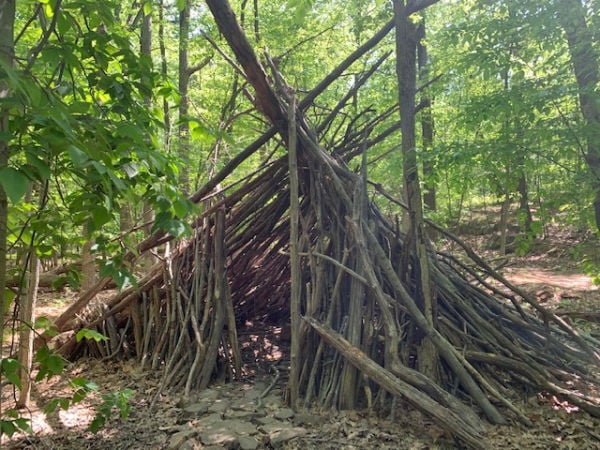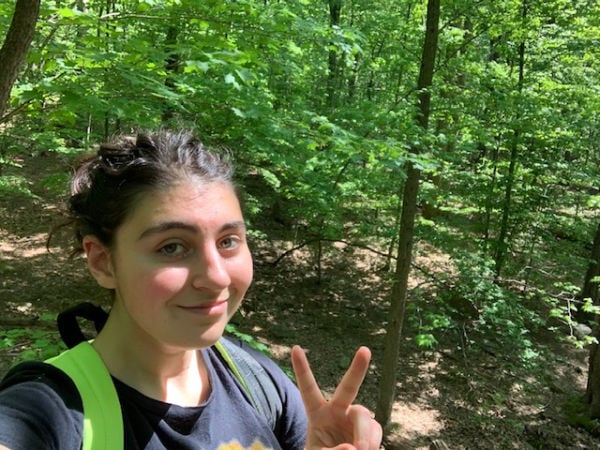
I’m sitting on a pollen-covered log that rests on a blanket of dead leaves and small twigs, slapping at my legs to rid myself of the feeling of insect legs crawling across my skin, bugs that have crawled up from the ground or out of holes in the tree bark or that happened to land on me after lazily drifting through the air. I’m in a shady spot, with only a speckling of sunlight able to pierce through the tree cover above, boughs of leafy green that signal the transition to summer is near. I’m just off the trail, looking out into a forest of oak and maple and ash, surrounded by new growth of grass and ferns. A breeze whispers through the trees, the leaves swaying in the dry May air. There’s birdsong to the west and south, trilling cries and single, high notes, one call coming clear through the air, and another soon in response. A leaf crackles nearby, trampled over by a stray chipmunk. Cobwebs glisten in the sunlight, their silky film near translucent in the daylight. There’s not a soul in sight. It’s only me, in the rustling solitude of the forest at midday.
I’m not in the wilderness, though, not off the grid and off a cellphone map. I’m in Eagle Rock Reservation, perhaps only a quarter of a mile in from the entrance on Afterglow Avenue. I’ve come here with no expectations of isolation, no hope to keep the forest to my own two eyes and ears. I am alone by chance and circumstance, by timing and location; I’m not off the beaten path, but merely a small way into it, sheltered from others by virtue of my willingness to clamber up a small ridge covered in a sea of decaying tinder soon to return to the earth from which it came. At any moment, my alone-ness could be ripped to shreds by the step of a hiking boot into my delicate web of solitude, and there’s nothing I could do to stop it.

In reality, there’s nothing particularly wild about Eagle Rock Reservation, for the forest doesn’t need to be held at bay by human hands: the forest must be protected from the voracious two-legged animals surrounding it. True to its name, Eagle Rock Reservation is a public park spread between Montclair, West Orange, and Verona, and it’s a 400-acre chunk of land that serves as a final barrier between what’s left of true green space in these towns and the greasy sprawl of asphalt and strip malls that so characterizes Northern New Jersey — and even then, parking lots and stone walls seem to have a way of creeping in here, from the manicured terrace surrounding the Highlawn Pavilion to the dirt lots dutifully cut out for cars arriving off the highway in West Orange.
This careful development is by design, though, for Eagle Rock isn’t really a forest. Instead, it’s nature quietly molded by the pencils of the Olmsted Firm, the firm created by the sons of Frederick Law Olmsted, the man who, with Calvert Vaux, created New York City’s Central Park, Brooklyn’s Grand Army Plaza, and countless other public works across the Northeast. (Verona Park and Newark’s Branch Brook Park were designed by his sons.) Olmsted sought to preserve a “natural feeling” in his design, and this “natural feeling” is immediately apparent from the armies of ants, mosquitos, and beetles that lord over the trails. But, look a bit closer, and one sees how the trails are just a bit too wide and winding to have been merely sliced out of the forest; here and there are painted wooden benches, stone bridges crossing over one of the many pitiful excuses for creeks that trickle through the reservation, and trail blazes made of plastic rectangles that have been nailed into the trees, the bark now made to bear the scars of the hammer and the drill. Just to the west of my log, there’s a fence surrounding a section of the forest, black and new and shiny; walk far enough, and you’ll find beer cans and bottle fragments on the forest floor, the scent of cheap alcohol lingering in the woodland air. This is the wild in name alone, in outward aesthetics and inner noise, but not in authentic, unrestrained form, in which crowded trees would block out the sun and grass would overtake the well-kept trails. This is nature deliberately packaged for human consumption, and many of us are none the wiser.

Such a perspective could seem cynical to one simply hoping to walk through the woods for a few hours, away from the hum and thrum of cars and capitalism — and besides, the trails make for a pleasant, easy walk. The soft manicuring of nature isn’t an issue if it means more people can enjoy the forest, and not have to worry about stepping on poison ivy on an overgrown, narrow trail. “So what if the reserve’s all by design? It’s a good design, and I enjoy being in it.”
As someone who’s lived amongst suburban sprawl my whole life, though — first in Bloomfield, then in Verona — I can’t help but sit and ponder the scaffolding of nature around me. I’ve been fortunate enough to travel to Europe three times, and each time I was there, I marveled at the way the towns didn’t roll into each other, as they do here, but are instead spread across tens of miles of winding roads and highways. In Iceland, there can be hours of driving before even encountering a sign of 21st century development; in Ireland, towns are nestled amongst rolling emerald hills; in Austria, small Tyrolean villages can only be seen from a distance by their church spires. There, it doesn’t feel as if nature has been cowed by the bulldozer and the cement truck, but has instead dictated where bricks and mortar can be laid.

By contrast, Verona sits in the middle of the Eastern Megalopolis, a corridor of unfiltered urban and suburban development from Washington, D.C. to Boston, Massachusetts. Here, the boundaries between towns are largely arbitrary, the only real differences between them the name of the football team or the degree to which redlining has painted the community Black or White. There is less a “Verona culture” and more a “Suburban Northern New Jersey culture” — for even as each town has its own internal politics and polemics, its own local heroes, they all form a quilt of smoke-spewing humanity across the Eastern Seaboard. Within this quilt of asphalt, concrete, steel, and glass, Eagle Rock is but a lone hole in its fabric, a spot left unpatched by the needle of eminent domain and the thread of the construction contractor. Eagle Rock is a 400-acre time capsule, a halfway reminder of what this part of America looked like before the 20th century, Dwight Eisenhower, and the dawn of the chain store. I might feel small sitting at the mercy of stinging bees and stray poison oak, but I know that, in reality, I’m the conqueror here, a 21st century transplant into a piece of land shielded by the mere ink and paper of the law from getting turned into a series of luxury co-ops and overpriced coffee shops. Much like its fellow Olmsted creation Central Park, Eagle Rock is but a square of green in an ocean of brown and gray, and I cannot help but feel a twinge of fear for its future as I think of the four-lane highway not far from it.

Even if it’s not “perfect woodland,” though, I still love the reservation and its faux-wild charm. Expeditions into Eagle Rock, whether alone or with friends form tick marks in my memory, page breaks between endless paragraphs of Bloomfield Avenue and the newly-renovated halls of VHS. After all, it’s better to have bug spray here than go without it, and there are countless scars on my legs from where I’ve scratched myself on a stray branch or rock. After all, for all its artificialness, all its marks of human touch, Eagle Rock is still a refuge from the world outside it, and it remains true to its Progressive Era vision of nature made useful for humans — in this case, useful for a day out and away from work, school, and life in our pulsing section of the country. I relish my time in Eagle Rock, and even as I’ve been in it countless times before, I’m still in awe at how quickly the noise of cars, trucks, and urban life fades away among the quiet majesty of the remaining old-growth trees. Verona can sometimes seem like a bubble, a 2.79 square-mile area entirely insulated from the world around it. But, to take a step back for a moment is to realize how Verona forms a piece of a much larger piece of human development, and it is head-spinning to consider how quickly deciduous forest was turned into the modern town we live in today. Eagle Rock is a pause from this rapid development, a reminder of what was here before us, even if it itself has been indelibly changed by human hands. Eagle Rock is a sanctuary — and we ought to be grateful for it.

You get a map of Eagle Rock’s trails at the bottom of this page..


Very cool. I also enjoy these spaces of green that remain in the urban and suburban fabric.
Have you heard of the Lenape Trail? It loops around from Newark, up to Montclair, and back down to South Mountain (including through Eagle Rock) It took me 2 days to complete it and it is largely paved paths through parks and on suburban streets.
Cheers!